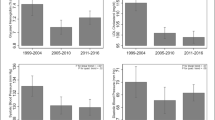Abstract
Background and aims
Seasonal variations in lifestyle, such as food intake and physical activity, have been reported. Glycemic control in type 2 diabetes mellitus (T2DM) may be affected by such changes. We investigated seasonal variations in glycemic control, food intake, and physical activity in type 2 diabetic patients.
Methods
This prospective observational study included 37 Korean female patients who had <8.0 % hemoglobin A1c (HbA1c) and managed diabetes by oral anti-diabetic drugs or lifestyle modification only. Participants underwent four or five assessments, including total physical activity (household, leisure-time, and occupational activity) (metabolic equivalent of test-h/day), food intake (kcal/day), HbA1c, and anthropometry every 3 months (August, November, February, May, and August in the Northern Hemisphere) over 1 year. When anti-diabetic drugs were changed, we analyzed the data just before the changes.
Results
The mean HbA1c levels (%) of August and November in 2008, and February, May, and August in 2009 were 7.0 ± 0.1, 6.9 ± 0.1, 7.2 ± 0.2, 7.4 ± 0.2, and 7.2 ± 0.2, respectively (P = 0.018). The change of HbA1c was nearly 0.5 % for the 1-year period. From August to May of the following year, there were also seasonal variations in food intake (1,872 ± 143, 1,739 ± 97, 1,673 ± 86, 1,561 ± 132, respectively; P = 0.013), and total physical activity [7.7 (3.7–14.6), 6.3 (2.8–10.4), 5.1 (2.7–12.6), and 11.2 (4.7–20.5), respectively; P = 0.048]. However, the seasonal variations of HbA1c and total physical activity became non-significant when farmers were excluded.
Conclusions
These data suggested that glycemic control, total physical activity, and food intake varied seasonally in Korean T2DM patients. These seasonal variations should be considered in education for glycemic control.

Similar content being viewed by others
References
UK Prospective Diabetes Study (UKPDS) Group (1998) Intensive blood-glucose control with sulphonylureas or insulin compared with conventional treatment and risk of complications in patients with type 2 diabetes (UKPDS 33). Lancet 352:837–853
Tuomilehto J, Lindström J, Eriksson JG, Finnish Diabetes Prevention Study Group et al (2001) Prevention of type 2 diabetes mellitus by changes in lifestyle among subjects with impaired glucose tolerance. N Engl J Med 344:1343–1350
Knowler WC, Barrett-Connor E, Fowler SE, Diabetes Prevention Program Research Group et al (2002) Reduction in the incidence of type 2 diabetes with lifestyle intervention or metformin. N Engl J Med 346:393–403
Sacks DB, Arnold M, Bakris GL, National Academy of Clinical Biochemistry et al (2011) Position statement executive summary: guidelines and recommendations for laboratory analysis in the diagnosis and management of diabetes mellitus. Diabetes Care 34:1419–1423
Carney TA, Guy SP, Helliwell CD (2000) Seasonal variation in HbA1c in patients with type 2 diabetes mellitus. Diabet Med 17:554–555
Ishii H, Suzuki H, Baba T, Nakamura K, Watanabe T (2001) Seasonal variation of glycemic control in type 2 diabetic patients. Diabetes Care 24:1503
Tseng CL, Brimacombe M, Xie M et al (2005) Seasonal patterns in monthly hemoglobin A1c values. Am J Epidemiol 161:565–574
Liang WW (2007) Seasonal changes in preprandial glucose, A1C, and blood pressure in diabetic patients. Diabetes Care 30:2501–2502
Higgins T, Saw S, Sikaris K et al (2009) Seasonal variation in hemoglobin A1c: is it the same in both hemispheres? J Diabetes Sci Technol 3:668–671
Furuta M, Tomisaka R, Yamana A et al (2012) Evaluation of seasonal changes in hemoglobin A1c in diabetic patients. Rinsho Byori 60:599–604
Matthews CE, Hebert JR, Freedson PS et al (2001) Sources of variance in daily physical activity levels in the seasonal variation of blood cholesterol study. Am J Epidemiol 153:987–995
Locke E, Coronado GD, Thompson B, Kuniyuki A (2009) Seasonal variation in fruit and vegetable consumption in a rural agricultural community. J Am Diet Assoc 109:45–51
Fowke JH, Schlundt D, Gong Y et al (2004) Impact of season of food frequency questionnaire administration on dietary reporting. Ann Epidemiol 14:778–785
Korea Ministry of Health and Welfare. Report on 2001/2002 Korean Nutrition Survey on Season (Korean)
Chen HS, Jap TS, Chen RL, Lin HD (2004) A prospective study of glycemic control during holiday time in type 2 diabetic patients. Diabetes Care 27:326–330
Hawkins RC (2010) Circannual variation in glycohemoglobin in Singapore. Clin Chim Acta 411:18–21
Ainsworth BE, Haskell WL, Whitt MC et al (2000) Compendium of physical activities: an update of activity codes and MET intensities. Med Sci Sports Exerc 32:S498–S504
Hirani V (2011) Relationship between vitamin D and hyperglycemia in older people from a nationally representative population survey. J Am Geriatr Soc 59:1786–1792
Berglund L, Berne C, Svärdsudd K, Garmo H, Melhus H, Zethelius B (2012) Seasonal variations of insulin sensitivity from a euglycemic insulin clamp in elderly men. Upsala J Med Sci 117:35–40
Isken F, Abraham U, Weickert MO et al (2011) Annual change in insulin sensitivity. Horm Metab Res 43:720–722
Holman RR, Cull CA, Turner RC (1999) A randomized double-blind trial of acarbose in type 2 diabetes shows improved glycemic control over 3 years (UK Prospective Diabetes Study 44). Diabetes Care 22:960–964
Black C, Donnelly P, McIntyre L et al (2007) Meglitinide analogues for type 2 diabetes mellitus. Cochrane Database Syst Rev. doi:10.1002/14651858.CD004654.pub2
Acknowledgments
This study was supported by a grant (O.H.R, 2008) from the Korean Diabetes Association. We gratefully acknowledge Deok-Ki Youn and Nam Hee Kim for their coordination and analysis of food intake in this study.
Conflict of interest
None of the authors have any conflict of interest.
Author information
Authors and Affiliations
Corresponding author
Rights and permissions
About this article
Cite this article
Ryu, OH., Lee, S., Yoo, H.J. et al. Seasonal variations in glycemic control of type 2 diabetes in Korean women. J Endocrinol Invest 37, 575–581 (2014). https://doi.org/10.1007/s40618-014-0080-y
Received:
Accepted:
Published:
Issue Date:
DOI: https://doi.org/10.1007/s40618-014-0080-y



